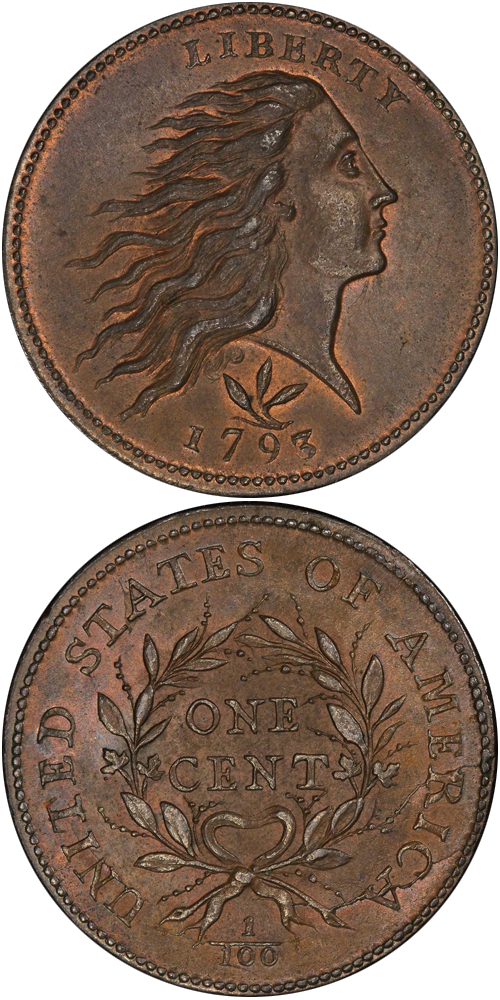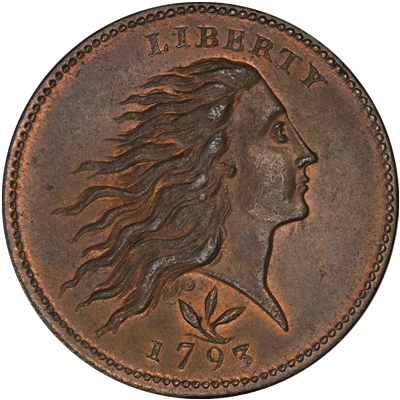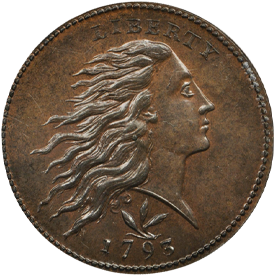Designed by: Adam Eckfeldt
Issue Date: 1793
Composition: Copper
Diameter: Average 26 to 28 mm
Weight: 13.47 grams (208 grains)
Edge: Vine and bars design, or lettered ONE HUNDRED FOR A DOLLAR
Business Strike Mintage: 63,353
Proof Mintage: None
The second major design in the cent series is the so-called Wreath style. The obverse was redesigned from the earlier motif and now features Miss Liberty in higher relief, with the hair details more pronounced, LIBERTY above her head, the date 1793 below, and above the date a sprig or leaf design. The reverse consists of an open wreath tied with a bow at the bottom, enclosing ONE CENT, with UNITED STATES OF AMERICA and the fraction 1/100 surrounding. Both obverse and reverse are protected by a high rim with a bead design between the rim and the field.
The Wreath style is the most often seen variety of 1793, although examples in all grades are scarce. A number of different die varieties were produced, some of which have a vine and bars design on the edge and others of which are lettered ONE HUNDRED FOR A DOLLAR. Examples can be found in all grades, in Fair through Uncirculated, although pieces in Extremely Fine or better preservation are seldom met with. During this period, the Mint acquired copper from many different sources, with the result that the surfaces of early half cents and cents are apt to vary considerably, even on higher grade pieces. More often than not, the fields of a piece show porosity or graininess.
Further Reading
By far the most plentiful of the 1793 cents are those of the Wreath variety. The obverse depicts a restyled head of Miss Liberty, facing to the right as on the Chain cent, but engraved in higher relief and with much more detail, particularly with regard to the hair. The word LIBERTY appears above, and the date 1793 is below. Above the date is a small sprig, or group of leaves attached to a short branch. Early issues have a vine and bars ornamentation on the edge, while later examples have the edge lettered ONE HUNDRED FOR A DOLLAR (lettering which was continued in use through part of 1795).
The relief of the designs and the protective high rims on the 1793 Wreath cents are such that even well-worn specimens are apt to show the date and most major features. This is in contrast to the 1793 Chain cents which, as earlier noted, usually are lightly defined on the obverse.
From the original estimated mintage of 63,353 pieces many hundreds of 1793 Wreath cents survive, perhaps even one or two thousand. These are spread over a number of different die variations as described in Penny Whimsy.
Examples are encountered today in a full range of conditions from Fair to Uncirculated, with most in the range of Good to Fine. Typically, specimens in Good to Very Fine grade show surface porosity or other irregularities. However, for the most part they are well struck and sharply defined. Examples in Extremely Fine and AU condition are quite elusive, and Uncirculated coins, while they exist, are major rarities. I have never seen one with a significant amount of mint red.
A curious and extremely rare variety of the 1793 Wreath cent is the so-called Strawberry Leaf variety. Instead of the typical sprig of three leaves and a small branch, the Strawberry Leaf variety displays a spray of three clover-type or strawberry-type leaves, each with three lobes. A blossom or, as Sylvester S. Crosby believed, a boll of cotton is attached to the stem.
Two different die varieties of the Strawberry Leaf cent are known, sharing a common obverse but differing in reverse characteristics. As a class the variety is exceedingly rare. The several known specimens are uniformly in low grades of Good or less.
The status of the Strawberry Leaf cents has been a subject for debate for many years. Some specialists have considered them to be patterns, others as regular circulating issues (but it is curious that no higher-grade specimens are known and that they are so elusive), and still others have viewed them as being contemporary counterfeits.








